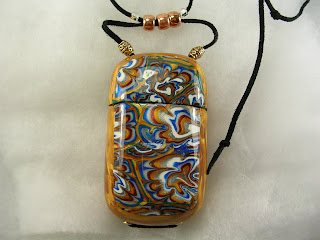


For as long as I remember I've been reading or buying books to teach me the subjects of my passions, from gardening to computers to art which was my first love.
Polymer clay books have been added to my collections and read voraciously. Many, maybe all, of the techniques I now use have been learned or absorbed from my reading.
Until just this week, however, I had never done the specific subject of a tutorial in any of my polymer clay, or jewelry-making books.
The first one was a scarab beetle from a tutorial in the August 2008 Polymer Cafe, written by the talented and accomplished Les Polinko, which grabbed me back then and finally, just lately followed, with encouraging results immediately. I used silver alcohol ink for the first time on one, and drilling, backfilling and sanding on the other one, which is a work in progress. I loved the ease with which these materialized and will have to make more.
Many of the species actually look like jewelry and will be a joy to form from polymer clay.
My next subject is based on a very cute steampunk fishy seen through a porthole. This came from "Steampunkery" by Christi Friesen, my latest addition to my ever expanding polymer clay library. I picked it up immediately without even opening it, knowing that I had to have it, having seen her work published for years and been enchanted by the adorable interpretations of her subjects, based on nature which, for me is home territory.
When I saw the project, I had to make one for myself and there are other tutorials that I plan to follow in that excellent, sometimes hilarious, and very informative read. The first of the Christi Freisen books to be added to my library.
The pendant is filled with resin in her book, unlike mine which I left as, is knowing that the eye bead sticks out too much to cover well without a dimpling effect, so adding bubbles instead to get a kind of 3D effect. My porthole frame is rough (maybe dented) and there would have been more gears and cool "steampunk" components if I could have found them but it's just for fun and I plan to refine my portholes in future projects.
I plan to do more along this concept also being more careful with depth of my eye placement, because I love the idea, and have now spent hours re-organizing my gears, gizmos, and other vintage findings, [which took a catastrophic tumble a while back, in a scenario involving a laundry basket piled high with multiple full component cases (satisfactory idea) and placement of said basket on a
small rolling mechanic's stool (very bad idea indeed!)].





























